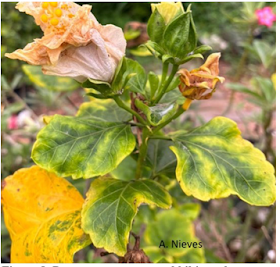Exploring Rice Hulls as a Cost-Effective Mulch in Florida's Nursery Production*
In the world of ornamental container production, weed control is a formidable challenge, consuming significant time and resources. While methods like preemergent herbicides, mulches, and hand labor are commonly employed to combat weeds, each has its drawbacks. An innovative approach gaining traction in west-central Florida is the use of rice hulls (RH) as a mulch. I have mentioned rice hulls in a previous post (https://hortagent.blogspot.com/2023/05/do-rice-hulls-prevent-weeds-in-woody.html) and wanted to follow up with the research that we conducted. We have determined that rice hull scan stop small weds from germinating but the question that lingered was the economic cost; our research delved into this question.
The Rise of Rice Hulls in Weed Control
Nursery production in Florida is heavily reliant on hand labor to manage weed growth, particularly in aged crops. Traditional methods such as preemergent herbicides and mulches have been effective in reducing weed emergence and biomass, but they come with certain limitations. Preemergent herbicides, for instance, can impact the growth of ornamental plants and pose environmental risks through runoff. On the other hand, mulches can drive up production costs due to material and labor expenses.
Rice hulls have emerged as a promising alternative. These hulls are the waste product left behind after rice grains are processed. When processed and dried, they form a dry, granular material that can be used as mulch. Research has shown that rice hulls can reduce the germination of small-seeded weeds like bittercress and creeping woodsorrel. However, until now, there has been a lack of cost/benefit analysis to guide growers in making informed decisions about their use.
The Research Methodology
Two studies conducted at a container nursery in Plant City, Florida, aimed to evaluate the efficacy of rice hulls as mulch. The first study, conducted in June 2023, involved recycled rice hulls re-used from the previous season. Bottlebrush liners were potted into containers, and preemergent herbicide was applied. Containers were then divided into two treatments: one with no rice hulls (NH) and one with a top-dress of rice hulls (RH) at about an inch thick on the surface of the pot. The study monitored weeding time and weed fresh weight over 12 weeks.
The second experiment, conducted in February 2024, used newly purchased rice hulls and involved Eagleston holly liners. This study was similar in design to the first, with data collected over eight weeks. In both studies, overhead irrigation was used.
Results and Discussion
The first experiment revealed high weed pressure throughout the study period. No significant differences in weeding time and weed weight were observed between the RH and NH treatments. Despite the assumption that rice hulls would reduce weed growth, the recycled hulls did not prove effective, likely due to degradation that occurred from the first season's use and the water absorption property they exhibited.
The second experiment showed lighter weed pressure. While the RH treatment required less weeding time, it did not significantly reduce weed fresh weight compared to the NH treatment. Additionally, using recycled rice hulls did not offer any cost benefits, as they were more expensive to employ requiring additional handling and storage.
Economic Analysis
The economic analysis revealed that rice hulls were not a cost-effective solution for weed control. Fresh rice hulls added $105.18 per 1,000 containers in material and labor costs for application and season weeding, while hand weeding every two weeks, and preemergent herbicide costs were significantly lower ($28.54). The use of recycled rice hulls also proved uneconomical due to reduced effectiveness and additional costs.
Conclusion
Based on our research, the use of rice hulls as mulch for weed control in container plants is not recommended under the experimental conditions. While they show potential, the costs associated with their use outweigh the benefits. Hand labor combined with preemergent herbicides remains the more economical approach. Future studies may explore ways to reduce costs, such as bulk purchasing, reducing transport costs, or automation of rice hull application, but for now, rice hulls do not offer a viable solution for Florida's nursery growers when they are applied by hand at planting.
*This study in its entirety will be published at a future date available at fshs.org.














